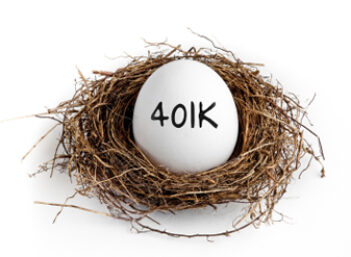When it comes to saving for retirement, the optimal keywords are 'tax' and 'deferred.' put them together and you have the common denominator of two of the most popular individual retirement savings plans.
Both the 401(k) plan and an individual retirement account (IRA) are comprised of contributions from pre-tax dollars. Essentially, you won't be paying taxes on the money contributed to the accounts or the interest and capital gains until you begin receiving distributions. And you'll be paying less money to Uncle Sam in the meantime, as the contributions to these accounts will decrease your taxable income.
Aside from that, IRAs and 401(k) plans are two very different methods of saving, with advantages and disadvantages to each.
In simple terms, a 401(k) is an employer-sponsored program which, in many cases, offers matching benefits. An IRA, on the other hand, is typically set up and managed by the individual. It features lower contribution limits but more freedom in allocating where the funds can be invested.
No earning individual is ever too young or too old to start tucking away a bit of a nest egg for retirement, and when scrutinizing options for retirement investments, these two plans stand out the most. Read on to learn which one may be right for you.
401(k)
Determining the personal value of signing onto a company’s 401(k) policy should be relatively easy. If the employer contributes partially or matches employee investment, it can make this option for retirement funding an extremely lucrative one.
Pros
Here are some of the benefits of utilizing the employer-sponsored 401(k) as a retirement plan.
- High contribution limits: As of 2011, 401(k) account owners are permitted to contribute up to $17,000 per year into their 401(k) if 49 years old or younger, and up to $22,500 if 50 or older.
- Income tax deduction during the year of contribution: During the same year you contribute to the 401(k) account, account holders can deduct the amount placed into the 401(k) from their net income.
- Deferred taxes: No tax on interest or capital gains until time of distribution.
- Matching: Employers are allowed to match up to 6% of your salary -- that's basically free money that your employer will be contributing to your retirement savings.
- Emergency withdrawals: You can borrow from your 401(k) in the event of an emergency or financial crisis.
Cons
401(k) plans are not without their own flaws. Here are a few to keep in mind.
- Limited flexibility: The plans offered by a large percentage of employers are noticeably short on options. Be sure that you have a good understanding of where the funds are being invested.
- IRA deductibles excluded: Plan holders that contribute to their 401(k) can reduce -- or possibly even eliminate -- the income tax deductions allotted for an IRA.
- Taxable income upon withdrawal: When a plan holder begins to withdraw money, it is taxed as additional income. There are also penalties for early withdrawal, with taxation up to 20% plus a 10% penalty if you withdraw before age 59 1/2.
- Required withdrawals at age 70 1/2: Plan holders must being receiving distributions by age 70 1/2. If you're still working at that time, you may be subject to a higher tax rate than if you were retired.
- Waiting periods: There is often a waiting period before employees can initiate a 401(k) plan with an employer, often times six months or up to one year.
Traditional IRA
An IRA is a method of saving money for retirement that is not an employee-sponsored 401(k) plan. Many who are self-employed or those who work for small businesses may choose this form of retirement planning. IRAs also have their own pros and cons to weigh.
Pros
- Tax-deferred: These funds go into a tax-deferred retirement plan account and can be set up at any time.
- Easy, cheap to start: In essence, plan holders set up their own IRAs, often with little or no help from any kind of financial planner. This saves not only time but cost.
- More investing options: While IRA holders may not have employers who match their contribution, they frequently have more investment options, including stocks (such as Apple, Inc. (Nasdaq: AAPL) and Netflix (Nasdaq: NFLX)), bonds, mutual funds and CDs.
- More flexible allocation: While tracking the performance of an IRA, holders who find an element of the account that is not performing as expected can easily tweak the allocation. This flexibility makes the IRA a top choice among serious investors.
- Roth IRA option: The Roth is a popular choice for converting a traditional IRA. The difference between the two is that contributions to a Roth are made with post-tax dollars. Roth IRAs grow tax-free and offer tax-free income withdrawals at age 59 1/2. The catch is that you have to pay taxes on the amount you convert as if it were ordinary income.
- Tax deductions: Contributions to a traditional IRA can be claimed as a tax deduction, dependent upon the policyholder’s income tax bracket.
Cons
- Limited contribution maximum: An IRA will allow the holder to deposit up to $5,000 if 49 years old or younger; or $6,000 if 50 or older.
- Low contribution rate: IRAs have a low contribution rate. For those beginning an IRA retirement plan later in life, the contribution rate may not be enough.
- Penalties for early withdrawal: As with the 401(k), there are penalties for early withdrawal.
- Required withdrawals at age 70 1/2: Policyholders are also required to begin withdrawing money by 70 1/2 years of age.
The Investing Answer: In general, those who are looking for the best option for their own personal retirement plan should always remember these two things:
- A 401(k) plan's employer-matched contributions and higher contribution allowances can help your tax-deferred retirement savings grow more quickly.
- An IRA's variety of investment offerings can better provide the flexibility to diversify your portfolio.
Additionally, borrowing against an IRA is not permitted except in rare circumstances, but a 401(k) plan does allow for this. A 401(k) can even help to provide 'emergency assistance' to help policyholders withdrawal as quickly and easily as possible when there are imperative needs for a household, such as a car or home repairs, or in case of a financial crisis.
In today’s economy, this may be an all-important decision-making element that could possibly sway prospective policyholders in the direction of the 401(k).
If your employer offers a 401(k), sign up for it. You can also open a traditional IRA on the side to maximize your retirement savings. Whenever possible, contribute as much as you can to the 401(k) first (which hopefully your employer will match) and then to the IRA. If you don't have access to a 401(k), a traditional IRA is an excellent choice for retirement savings, offering tax-deferred growth.



